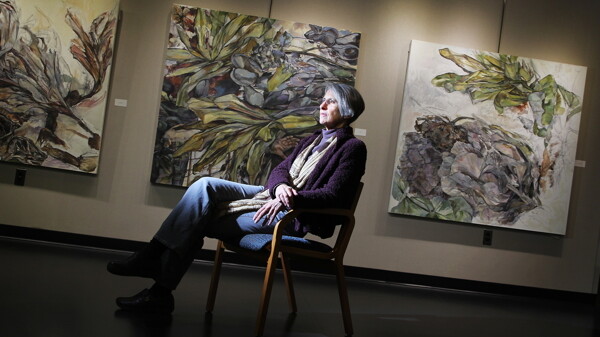Still Life Unbound
Barbara Shafer branches out with plant paintings
Hope Greene, photos by Andrea Paulseth |

This month, the L.E. Phillips Memorial Public Library is showing “Plant Forms,” an exhibit of new work by award-winner local artist Barbara Shafer. Shafer is a long-standing artistic presence in Eau Claire. A sculptor, painter, and dancer, she began teaching visual art at UW-Eau Claire in 1969 and since then has participated in the artistic life of Eau Claire through instruction, exhibition, and performances. Two years ago she retired from teaching at the university and now focuses on painting and teaching modern dance in her Banbury Place studio. Shafer’s artwork is in numerous collections across the United States, and is on permanent display at various venues around the area.
Until fairly recently, Shafer has been focusing her 2D exploration of dancers and dancing through paintings of the human figure. This new work departs from that subject matter as Shafer has become, in her words, “intrigued with dried plants.” She tells the story that four years ago, “My husband and I decided not to get a Christmas tree and instead bought a large floral bouquet. It started to dry and I thought, ‘This is interesting. I have to paint one of these.’ I started to paint single plants and became really excited about them. Later a dear friend was diagnosed with cancer and during her treatment her oncologist said she could not have any bouquets in her home so she brought some to me. I thought she should have a record of the bouquets so I made her a painting.” After painting the bouquet Shafer began to work with more complex arrangements of multiple flowers and plants in a single composition.
When written on a page, dried up plants may not sound like the most meaty and satisfying subject matter, but Shafer’s handling of them is compelling. Compelling for her as well, as she states that the examination of the plants as opposed to human bodies “permitted her to use drawing and paint surfaces more expressively,” bringing additional freedom to the work. That freedom and expressive technique – combined with the great complexity of forms and lines colliding and crossing in a bouquet – creates compositions that seem to be in flux, in danger of falling apart from their own lively vibrations. While the basic compositional setup for many of the pieces seems to be related to a fairly traditional still-life convention – putting out a vase of flowers and painting it – there is nothing still about these still lifes.
The show consists of 20 paintings ranging in size from two-feet-by-four-feet to four-feet-by-four-feet. The work is split up, as exhibitions at the library often are, between the lower level by the computer banks, the staircase, and the second floor gallery. The real payoff of this particular exhibition is in the brilliantly lit space of the gallery where Shafer’s paintings are given the opportunity to claim the area as their own. Shafer writes in her statement, “I would like people to walk into this show and find themselves surrounded by large lively plants.” This is certainly achieved in the second-floor gallery space. Indeed, the plants are painted so large that they take on human proportions.
It may be incorrect to say, as I did above, that the subjects of these paintings are dried or harvested plants when the works are considered in the light of Shafer’s career of responding to dancers. It seems more correct to say the subject of these paintings is movement. Consider the example of two of the large paintings, “September 2013” and “March 2012.” Dried bouquets do not generally move on their own, they usually sit in a vase and quietly collect dust. These bouquets are on the move, cascading downward, flinging petals across, cracking, obscuring, wrenching, falling. And the painter’s marks range from boldly stated outlines to barely seen traces of charcoal clinging to the white backgrounds, from harsh stabbings of saturated purples, to palely laid yellow washes, Shafer’s movements and decisions are as apparent as if she had just danced the canvas for us. As she says, “These paintings have to do with how I move and how I see movement. There is a serious correlation between how I paint, how I perceive paint and the dance.” It is significant to the poetry of the works that the painted plants are past flowering and fruiting and are in the process of decline. The enlarged seed heads and withering petals crack and bow as they drop in a firestorm of vibrant motion out of bloom and into decay, and invite an emotional participation in the natural cycle of rhythm and change, of that imprecise casting forward into time that is our life.
“Plant Forms” runs through Nov. 24 at the L.E. Phillips Memorial Public Library, 400 Eau Claire St., where it can be viewed during regular opening hours. For more information visit www.ecpubliclibrary.info or call (715) 839-5004.


















